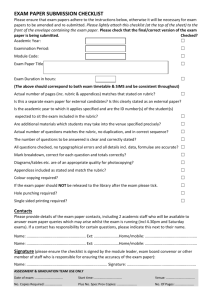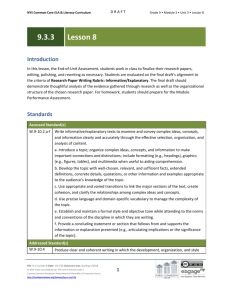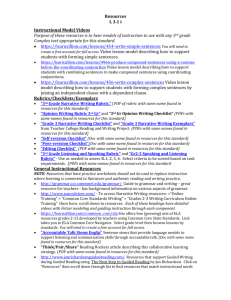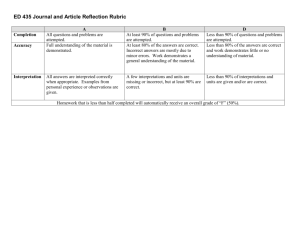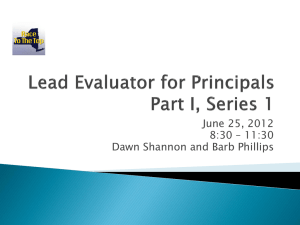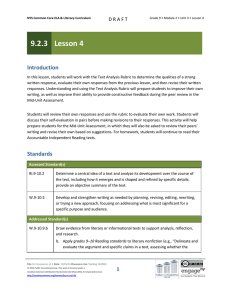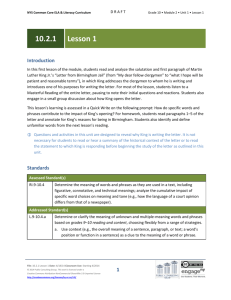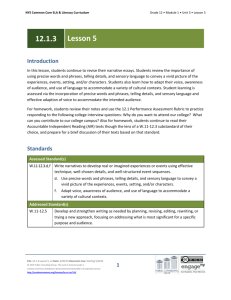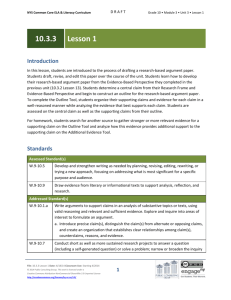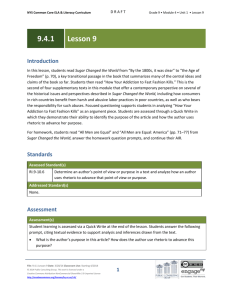1.87 MB - EngageNY
advertisement
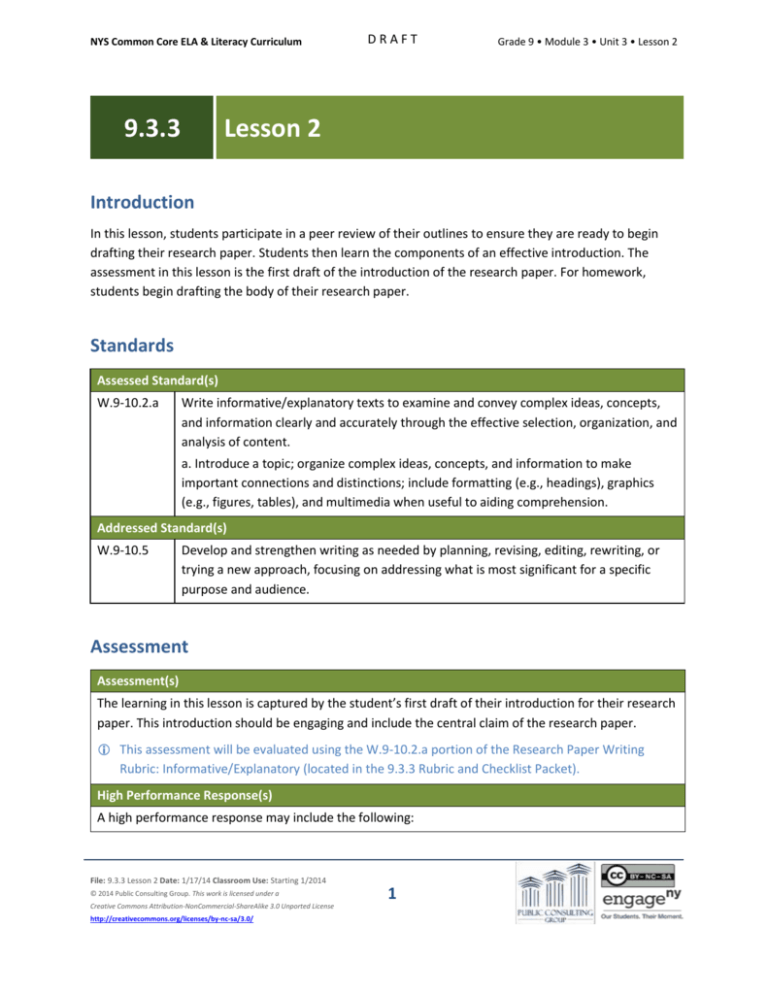
NYS Common Core ELA & Literacy Curriculum 9.3.3 DRAFT Grade 9 • Module 3 • Unit 3 • Lesson 2 Lesson 2 Introduction In this lesson, students participate in a peer review of their outlines to ensure they are ready to begin drafting their research paper. Students then learn the components of an effective introduction. The assessment in this lesson is the first draft of the introduction of the research paper. For homework, students begin drafting the body of their research paper. Standards Assessed Standard(s) W.9-10.2.a Write informative/explanatory texts to examine and convey complex ideas, concepts, and information clearly and accurately through the effective selection, organization, and analysis of content. a. Introduce a topic; organize complex ideas, concepts, and information to make important connections and distinctions; include formatting (e.g., headings), graphics (e.g., figures, tables), and multimedia when useful to aiding comprehension. Addressed Standard(s) W.9-10.5 Develop and strengthen writing as needed by planning, revising, editing, rewriting, or trying a new approach, focusing on addressing what is most significant for a specific purpose and audience. Assessment Assessment(s) The learning in this lesson is captured by the student’s first draft of their introduction for their research paper. This introduction should be engaging and include the central claim of the research paper. This assessment will be evaluated using the W.9-10.2.a portion of the Research Paper Writing Rubric: Informative/Explanatory (located in the 9.3.3 Rubric and Checklist Packet). High Performance Response(s) A high performance response may include the following: File: 9.3.3 Lesson 2 Date: 1/17/14 Classroom Use: Starting 1/2014 © 2014 Public Consulting Group. This work is licensed under a Creative Commons Attribution-NonCommercial-ShareAlike 3.0 Unported License http://creativecommons.org/licenses/by-nc-sa/3.0/ 1 NYS Common Core ELA & Literacy Curriculum DRAFT Grade 9 • Module 3 • Unit 3 • Lesson 2 Plenty of people say their pets are intelligent, emotional creatures. Some people might even argue that their dog is smarter than their neighbor. But how smart are animals really? Over the centuries, people have offered many ways of thinking about animal cognition—that is, the mental capacities of animals. In the seventeenth century, René Descartes claimed that animals do not think at all, and that is why they are not able to speak (Castro and Wasserman). Recently, though, many researchers have begun to observe extraordinary signs of intelligence in dolphins, chimps, dogs, and even parrots—from following instructions and using tools, to being able to speak and do math. But while some animals may show signs of intelligence, a question remains: How does animal intelligence compare to human intelligence? That is to say, while we think that humans are smarter, how much smarter are we, exactly? The question still has no clear answer; it depends on how we measure intelligence and whether or not it is fair (or even possible) to compare humans to animals. Vocabulary Vocabulary to provide directly (will not include extended instruction) multimedia (n.) – multimedia is the combined use of several media (means of communication) e.g., a presentation that incorporates video and sound formatting (n.) – the organization, plan, style, or type of something Vocabulary to teach (may include direct word work and/or questions) None.* *Students will encounter domain-specific vocabulary related to their individual research question/problem by reading, annotating, and recording notes on various sources. Students will track some of this vocabulary in their Vocabulary Journal when conducting independent searches during class and for homework. Lesson Agenda/Overview Student-Facing Agenda % of Lesson Standards & Text: Standards: W.9-10.2.a, W.9-10.5 Text: Sources from research Learning Sequence: File: 9.3.3 Lesson 2 Date: 1/17/14 Classroom Use: Starting 1/2014 © 2014 Public Consulting Group. This work is licensed under a Creative Commons Attribution-NonCommercial-ShareAlike 3.0 Unported License http://creativecommons.org/licenses/by-nc-sa/3.0/ 2 NYS Common Core ELA & Literacy Curriculum 1. 2. 3. 4. 5. DRAFT Grade 9 • Module 3 • Unit 3 • Lesson 2 Introduction of Lesson Agenda Homework Accountability Drafting Introductions Lesson Assessment Closing 1. 2. 3. 4. 5. 10% 20% 30% 30% 10% Materials Student copies of the 9.3 Common Core Learning Standards Tool (refer to 9.3.1 Lesson 1) Copies of the 9.3.3 Rubric and Checklist Packet for each student Student copies of the Outline Tool (refer to 9.3.3 Lesson 1) Student copies of the Additional Evidence Outline Tool (refer to 9.3.3 Lesson 1) Learning Sequence How to Use the Learning Sequence Symbol Type of Text & Interpretation of the Symbol 10% no symbol Percentage indicates the percentage of lesson time each activity should take. Plain text indicates teacher action. Bold text indicates text dependent questions. Italicized text indicates a vocabulary word. Indicates student action(s). Indicates possible student response(s) to teacher questions. Indicates instructional notes for the teacher. Activity 1: Introduction of Lesson Agenda 10% Begin by reviewing the lesson agenda and assessed standard for this lesson: W.9-10.2.a. Inform students that in this lesson, they finalize their outline and draft an introduction. Students follow along and read the agenda. Ask students to read standard W.9-10.2.a on their 9.3 Common Core Learning Standards Tool and assess their familiarity with and mastery of it. If students are unfamiliar with the language of this standard, explain that formatting is the organization, plan, style, or type of something. Also, multimedia is the combined use of several File: 9.3.3 Lesson 2 Date: 1/17/14 Classroom Use: Starting 1/2014 © 2014 Public Consulting Group. This work is licensed under a Creative Commons Attribution-NonCommercial-ShareAlike 3.0 Unported License http://creativecommons.org/licenses/by-nc-sa/3.0/ 3 NYS Common Core ELA & Literacy Curriculum DRAFT Grade 9 • Module 3 • Unit 3 • Lesson 2 media (means of communication) e.g., a presentation that incorporates video and sound. Remind students to record the definitions of multimedia and formatting in their vocabulary journals. Display and distribute the 9.3.3 Rubric and Checklist Packet. Inform students their research papers will be evaluated using the Research Paper Writing Rubric: Informative/Explanatory. Explain to students that each part of this rubric is aligned to specific Common Core Standards that are targeted to assess components of informative and explanatory writing as well as relevant language standards. Inform students that the 9.3.3 Rubric and Checklist Packet is a resource they will refer to as they engage in the writing process throughout this unit. At the front of the packet is the Research Paper Writing Rubric: Informative/Explanatory. The rest of the packet contains excerpted portions of the rubric aligned to specific targeted standards. Each excerpted standard rubric row also contains space for feedback and a corresponding checklist that will be used to guide peer review, teacher feedback, and assessment in this unit. Instruct students to briefly review the 9.3.3 Rubric and Checklist Packet. Students follow along and review the 9.3.3 Rubric and Checklist Packet. Activity 2: Homework Accountability 20% Instruct students to form pairs and take out their Additional Evidence Outline Tool. Inform students that they need to make sure they have a strong outline and central claim to direct their writing before they start to draft their research paper. Remind students that a purposeful and clear outline will assist them throughout the process of drafting their research paper. Instruct students to share their Additional Evidence Outline Tool with a classmate to do a peer review of their organizational plan for their research paper. Remind students that a fully planned outline will include the central claim, all sub-claims, evidence supporting the central claim, and analysis of the evidence. Students form pairs and do a peer review of their Additional Evidence Outline Tools. Student responses will vary according to their individual research and outline. Consider sharing with students the Model Additional Evidence Outline Tool as a reminder of what an exemplar response looks like. File: 9.3.3 Lesson 2 Date: 1/17/14 Classroom Use: Starting 1/2014 © 2014 Public Consulting Group. This work is licensed under a Creative Commons Attribution-NonCommercial-ShareAlike 3.0 Unported License http://creativecommons.org/licenses/by-nc-sa/3.0/ 4 NYS Common Core ELA & Literacy Curriculum DRAFT Grade 9 • Module 3 • Unit 3 • Lesson 2 Activity 3: Drafting an Introduction 30% Explain that students will begin the first draft of their research paper. Once the outline is complete, there are many ways to begin writing a paper. Inform students the focus of this lesson is writing the introduction of the research paper. What do you know about an introduction based on the work you have done in the past? Students share their understanding of an introduction. An introduction is the first part of a paper or essay. The introduction should tell the reader the central claim of the paper. It can also be the “hook” that grabs readers’ attention. The introduction should be a high-level overview of the paper and not include all of the smaller details in the paper. Potential student responses are drawn from the previous instruction of introductions in this curriculum. Refer to 9.1.1 Lesson 15. Explain that an introduction is the first part of the research paper. An introduction should be interesting and get the reader’s attention, give context for what will be covered in the research paper, preview what will follow, and include the central claim of the research paper. A good introduction should be one to two paragraphs long. Typically, the central claim should be the last sentence of the introduction. Explain to students that they should include their strongest claims in the introduction in a clear, organized fashion, but they do not need to include all the evidence that supports the claims—that will come in the body of the research paper. However, if it makes sense to do so, students can choose to put into the introduction one or two pieces of evidence that support the strongest claims in their paper. Students follow along. Display an exemplar introduction for students and ask them to read the introduction and then form pairs for a Turn-and-Talk to briefly discuss their understanding of the introduction. Exemplar Introduction: Plenty of people say their pets are intelligent, emotional creatures. Some people might even argue that their dog is smarter than their neighbor. But how smart are animals really? Over the centuries, people have offered many ways of thinking about animal cognition—that is, the mental capacities of animals. In the seventeenth century, René Descartes claimed that animals do not think at all, and that is why they are not able to speak (Castro and Wasserman). Recently, though, many researchers have begun to observe extraordinary signs of intelligence in dolphins, chimps, dogs, and even parrots—from following instructions and using tools, to being able to speak and do math. But while some animals may show signs of intelligence, a question remains: How does animal intelligence compare to human intelligence? That is to say, while we think that humans are smarter, how much smarter are we, exactly? The question still has no clear answer; it File: 9.3.3 Lesson 2 Date: 1/17/14 Classroom Use: Starting 1/2014 © 2014 Public Consulting Group. This work is licensed under a Creative Commons Attribution-NonCommercial-ShareAlike 3.0 Unported License http://creativecommons.org/licenses/by-nc-sa/3.0/ 5 NYS Common Core ELA & Literacy Curriculum DRAFT Grade 9 • Module 3 • Unit 3 • Lesson 2 depends on how we measure intelligence, and whether or not it is fair (or even possible) to compare humans to animals. Students read the example introduction and form pairs to discuss it in a Turn-and-Talk. Explain that there are a lot of different methods for creating an interesting introduction that will grab the reader’s attention. Explain that students could present a problem, question, or interesting fact associated with their research. They could also retell an interesting story they came across in the course of their research. Using descriptive words that will bring the reader into the context of the topic is also a great way to begin a research paper. Instruct students to discuss the following questions in pairs before sharing with the entire class. What method did the author of the introduction use to get the attention of the reader? Is this an effective method? The author started their introduction writing about pets to get the reader’s attention. This is an effective method because a lot of people have pets and think their pets are smart. What is the author going to be writing about in the paper? What is the central claim of this research paper? The author is going to write about animal intelligence compared to human intelligence. They mention dolphins, monkeys, dogs, and parrots and experiments associated with these animals. The central claim of this research paper is that there are different ways to measure intelligence, and it may not be possible to fairly compare animals and humans. Differentiation Consideration: Consider forming student research groups and have them brainstorm interesting ways to introduce their research paper. Allow each student to write a sample, and then instruct students to have a round-robin style discussion wherein each student passes their sample to a member of their group and the group discusses each sample and which sample interested them the most and why. Activity 4: Lesson Assessment 30% Explain that students will now independently draft their own introductions for the lesson assessment. Remind students that this is a first draft, and while they should be focusing on the conventions established for an effective introduction, they will be working to edit and refine their writing in later lessons. Inform students that the assessment will be evaluated using the W.9-10.2.a portion of the Research Paper Writing Rubric: Informative/Explanatory. Remind students to refer to the W.9-10.2.a checklist in the 9.3.3 Rubric and Checklist Packet as they are writing their introductions. File: 9.3.3 Lesson 2 Date: 1/17/14 Classroom Use: Starting 1/2014 © 2014 Public Consulting Group. This work is licensed under a Creative Commons Attribution-NonCommercial-ShareAlike 3.0 Unported License http://creativecommons.org/licenses/by-nc-sa/3.0/ 6 NYS Common Core ELA & Literacy Curriculum DRAFT Grade 9 • Module 3 • Unit 3 • Lesson 2 The process of writing a research paper will involve drafting, peer review, editing, and revising. If access to technology is available, consider using a cloud or electronic storage system (MS Word, Google Drive, etc.) that allows each student to write and track changes using a word processing program. If technological resources are not available, use the established classroom protocols for drafting, editing, and revising hard copies. Students independently draft the opening paragraph of their paper. Consider having students email their introductions to the teacher, uploading them to a cloud for teacher access, or handing in a copy on paper for assessment. See the High Performance Response at the beginning of this lesson. Activity 5: Closing 10% Display and distribute the homework assignment. For homework, instruct students to draft the first paragraph of the body of their research paper using their Outline Tool and Additional Evidence Outline Tool to guide their writing. Inform students that they will receive instruction on crafting strong body paragraphs in the following lessons. This body paragraph is a first draft and should be a full paragraph using complete sentences. It should clearly articulate all the relevant information about the first claim that students have collected on their Outline Tool and Additional Evidence Outline Tool. Students follow along with the homework assignment. Homework For homework, draft the first paragraph of the body of your research paper. Be sure to clearly articulate all of the relevant information from your Outline Tool and Additional Evidence Outline Tool while you are drafting your paragraph. File: 9.3.3 Lesson 2 Date: 1/17/14 Classroom Use: Starting 1/2014 © 2014 Public Consulting Group. This work is licensed under a Creative Commons Attribution-NonCommercial-ShareAlike 3.0 Unported License http://creativecommons.org/licenses/by-nc-sa/3.0/ 7
